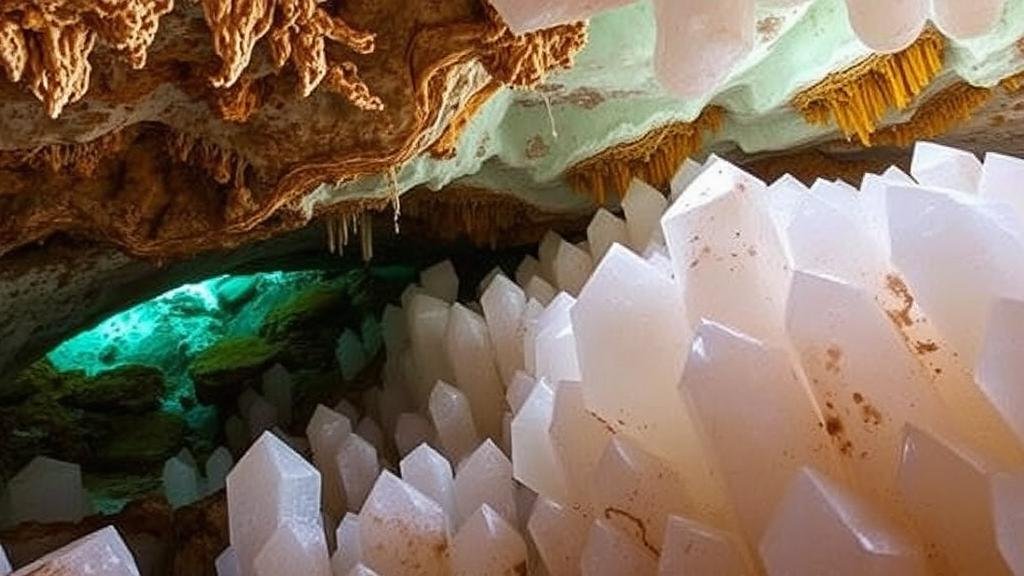Quartz Caverns: Exploring Underground Wonderlands for Crystalline Beauty
Quartz Caverns: Exploring Underground Wonderlands for Crystalline Beauty
Quartz caverns, often regarded as natures crystalline masterpieces, provide rockhounds and mineral collectors with a stunning glimpse into the Earths geological processes. These underground formations, filled with drusy quartz, quartz crystals, and other associated minerals, serve as both scientific marvels and sought-after specimens for collectors. In this article, we will explore the unique characteristics of quartz caverns, their formation processes, and practical tips for collectors looking to delve into this fascinating world.
The Formation of Quartz Caverns
Quartz caverns are primarily formed through a combination of geological and hydrothermal processes. Typically, these caves develop within volcanic or sedimentary rocks where silica-rich fluids have been able to penetrate through fractures and voids. This process converts dissolved silica into quartz crystals over thousands, if not millions, of years. Key processes involved in the formation of quartz caverns include:
- Hydrothermal Activity: Hot, mineral-rich water moves through rock formations, depositing silica as it cools, which leads to the creation of quartz veins and cavities.
- Erosion: The natural erosion of surrounding rock can expose quartz deposits, forming visible caverns and enhancing accessibility for collectors.
Studies have shown that conditions such as temperature, pressure, and fluid chemistry significantly affect the size and quality of quartz crystals formed. For example, quartz crystals from the famous Cave of Crystals in Naica, Mexico, can reach sizes of up to 12 meters and are renowned for their clarity and visual impact.
Features of Quartz Caverns
Quartz caverns possess distinctive features that make them appealing to rockhounds and collectors. Noteworthy characteristics include:
- Geometric Formations: The aesthetic allure of quartz caverns often lies in their surreal formations, such as stalactites and stalagmites made entirely of crystalline quartz.
- Druse: The term druse refers to a layer of minute quartz crystals that line the walls of a cavern, creating shimmering surfaces that are a collectors delight.
- Variety of Colors: While many quartz caverns showcase clear or milky quartz, they can also feature vibrant hues due to the presence of iron, manganese, or other trace minerals that can alter the color of quartz.
Collecting Quartz Specimens
For those interested in building a collection of quartz from caverns, its essential to follow best practices to ensure both ethical collecting and the preservation of natural environments. Here are some actionable tips:
- Research Legalities: Before exploring any cave or cavern, check for mining rights and regulations to ensure you are permitted to collect specimens.
- Use the Right Tools: Equip yourself with hand tools such as chisels, hammers, and safety goggles to safely extract quartz specimens without damaging the surrounding formations.
- Practice Sustainability: Collect only what you need, and refrain from disturbing delicate ecosystems within the caverns. Leave no trace of your visit to preserve these natural wonders for future collectors.
Also, joining local rockhounding clubs can provide valuable insights and resources for finding and identifying quality quartz formations.
Notable Quartz Caverns Worldwide
Some locations around the globe are particularly famed for their impressive quartz caverns. These include:
- The Cave of Crystals: Located in Chihuahua, Mexico, this cavern is celebrated for its enormous selenite crystals, showcasing nature’s grandeur on an unparalleled scale.
- The 12th Century Crystal Caves: Found in Kentucky, USA, these caves contain exquisite calcite and quartz formations, attracting geologists and collectors alike due to their diversity and prominence.
Conclusion
Quartz caverns represent not just geological and mineralogical marvels, but also offer rockhounds and mineral collectors an unparalleled opportunity to connect with the natural world. Through proper understanding, ethical collecting practices, and an appreciation for these subterranean forms of beauty, enthusiasts can enjoy the thrilling journey of exploration and discovery. Always remember to respect and protect the spaces that host these magnificent formations, ensuring their beauty can be enjoyed for generations to come.



